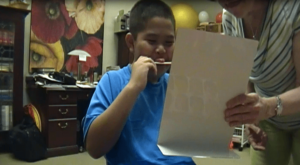Blog
From Silence to Sound
Non-verbal Ten Year Old Boy with Autism and Apraxia Gains Speech
Hank’s Story-Part 1
Autism and Verbal Apraxia Symptoms Treated from a Multi-Sensory Paradigm
Hank came to see me about the same time I was finishing therapy with Braden. I was feeling more confident with combining strategies to address more complex issues with suspected deficits in auditory processing. Hank was autistic, mentally challenged, non-verbal, and severely apraxic. I was not sure how well he understood running speech, and I was suspicious that he might not have the cognitive abilities to engage in the treatment strategies. However, I saw a brightness in his eyes now and then, which encouraged me that it was worth a try. I used a multi-sensory approach involving movement, object and picture matching, tactile stimulation.
Referred to Physician for Inner Ear Evaluation
I referred Hank to a specialty M.D. physician who evaluated and treated underlying physical issues. He diagnosed Hank as having an inner ear virus and prescribed a protocol to address it. Hank made progress in gaining calmer focused attention, demonstrating that he had the capacity to understand and learn. I suspected his hearing and discrimination was quite compromised because of the inner ear virus being treated medically.
https://www.ctsdallas.com/resources/recommended-reading/ See Autism Spot Videos of Jane # 4 & 5.
Early Improvements

Intensive Therapy with Multiple Sensory Inputs
Hank loved playing therapeutic games on the computer and was good with those requiring visual reasoning and memory, but very poor with simpler games requiring listening skills. He was now able to blow devices and balloons independently with self- crimping, whereas producing an air stream on request from his mouth had been previously impossible. Hank was barely making any vocalization and his ability to imitate speech-like sounds was nonexistent even after several months of treatment.
Hank participated in a ten day program of intensive therapy using The Listening program and cognitive skill input. He began vocalizing but still was not using speech-like sounds. Following the ten-day program he began using The Listening Program with bone conduction equipment at home. His attention and focus continued to improve and he became more available to learn and be a part of his family and school community. https://www.ctsdallas.com/services/therapies/intensive-therapy-programs
Hank could now sustain focus attention for task up to 5 minutes and was anticipating familiar routines. He was communicating non-verbally through gestures but no signs. He responded inconsistently to pictures which made augmentative communication a low priority at this time. Hank took a break from speech therapy to participate in sessions with a neurologist doing neuro-feedback.
